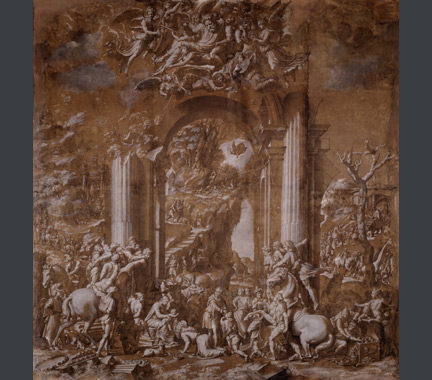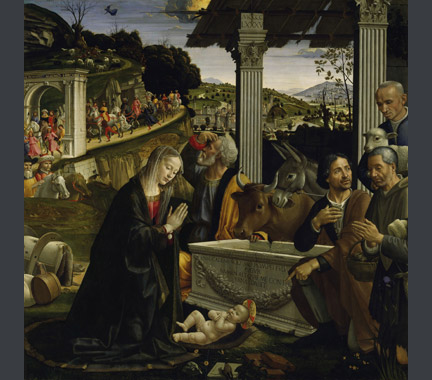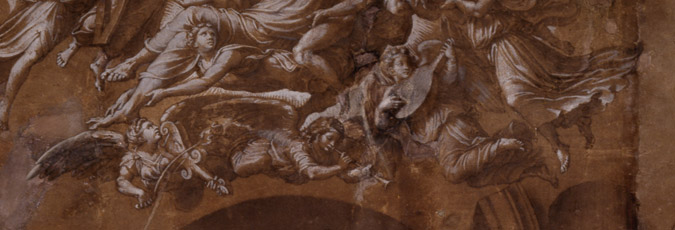Baldassare Peruzzi (1481–1536)
'The Adoration of the Kings', about 1522–3
Pen and ink and brown wash on paper tinted brown, 112.5 x 107 cm
The British Museum, London. © The Trustees of the British Museum

The monumental arch looming from the clouds in the centre of this work is in an advanced state of decay. The fluted columns to either side of it are broken – a cylindrical section from one of them can be seen prominently placed on the ground in front of the structure – and vegetation has begun to grow over the remains. The arch itself only barely survives, having been reduced to an isolated central segment, shorn of the more elaborate ornamental architecture that would once have encased it, fragmentary remains of which (an austere entablature, the beginnings of a profiled arch) can still be seen on the right-hand side of the edifice. It is possible to deduce that Peruzzi intended the building to be read as the ruins of a three-bayed triumphal arch from the springing of a lower arch on the right, which is half the height of the main arch (proportions that in turn reflect the relationship of the main and side arches on Ancient Roman triumphal arches such as that of Constantine) and from the openings to either side behind the central group of figures, which can be seen as connecting passages to these now-lost side arches. The careful depiction of the arch reveals the hand of a painter who was also an antiquarian; many drawings by Peruzzi of architectural fragments, inscriptions and entire ruins in Rome and the Italian countryside survive.1
The ruined arch
The symbolism of the ruined arch is the same as that in the works by Verrocchio and Botticelli in this publication, namely the fall of the old, pagan order and its replacement by the Christian faith. Nonetheless, although the symbolism may be the same, the architecture used to carry that message is different (an arch rather than a ruined temple or basilica), and it lacks the final iconographical element of the hut among the ruins. As an element in depictions of the Adoration of the Kings, the triumphal arch can be found in an ‘Adoration of the Kings’ (1490) in San Domenico, Siena by Francesco di Giorgio Martini (like Peruzzi a Sienese painter-architect), and in Ghirlandaio's ‘Adoration of the Kings’ (1491) in Santa Maria Novella, Florence .2 Furthermore, Peruzzi's background arch and processing figures seem to have been inspired by Ghirlandaio's ‘Adoration of the Shepherds’ in the Sassetti Chapel in Santa Trinità, Florence (fig. 1).

As a type of building, the arch carries different messages to the ruined basilica. It is both a triumphant structure, making its ruin a humbling of pagan pomp and pride, and an edifice designed to celebrate entrance and frame processions, a combination that makes it entirely fitting as a backdrop to the arrival of Christ into the world. It is important to consider also the relationship of the ruined arch to the rest of the architecture in Peruzzi’s drawing, in particular to the town on the far right. This town contains a structure reminiscent of the Castel Sant’Angelo, the papal castle in Rome, making it possible, as Tessari argues, that Peruzzi was making a deliberate architectural reference to the past grandeur of Rome and its present revival under the 16th-century popes.3
The materiality of architecture
The fact that Peruzzi was a painter-architect, demonstrated most famously by the Villa Farnesina and the Palazzo Massimo alle Colonne in Rome, is crucial to understanding the architectural character of this arch.4 Clearly split between its structural underpinnings and the ornamental cladding, the arch shows an awareness not just of architecture as decoration but also as an architectonic structure with scale, weight and depth. This emerges particularly in comparison with Botticelli’s 'Adoration of the Kings', where ornament and underlying structural support are – arguably – fused, resulting in a building that for all its grandeur is only partly convincing architectonically. Peruzzi’s arch certainly carries more of a sense of the materiality of architecture, shown by its interactions with surrounding figures. On the right of the arch, for example, a figure encircles a column with an outstretched arm, using it for support in a way that expresses its solidity. This solidity, however, exists in balance with the scenographic nature of the structure.
Much has been written on the influence of Peruzzi’s stage designs upon both his architecture and his painting, an exchange that can be seen directly at work in this drawing.5 The majority of the figures are strung like a frieze along the foreground of the work, while immediately behind them the arch forms a monumental backdrop to the unfolding drama.6 Standing alone in the most unlikely of settings (most triumphal arches would at this point have been entirely hemmed in by buildings),7 this arch is architecture at its most purely theatrical and rhetorical, ostensibly weighty and ‘real’, yet at the same time purely symbolic.
Alasdair Flint
Selected literature
Vasari 1967, pp. 264, 409; Gould 1975, pp. 196–7; Bruschi 1987, pp. 335–7; Frommel 1987, p. 27 Tessari 1995, pp. 59–62.
This material was published in April 2014 to coincide with the National Gallery exhibition 'Building the Picture: Architecture in Italian Renaissance Painting'.
To cite this essay we suggest using
Alasdair Flint, ‘Baldassare Peruzzi, The Adoration of the Kings’ published online 2014, in 'Building the Picture: Architecture in Italian Renaissance Painting', The National Gallery, London, http://www.nationalgallery.org.uk/research/research-resources/exhibition-catalogues/building-the-picture/architectural-time/peruzzi-adoration-of-the-kings

